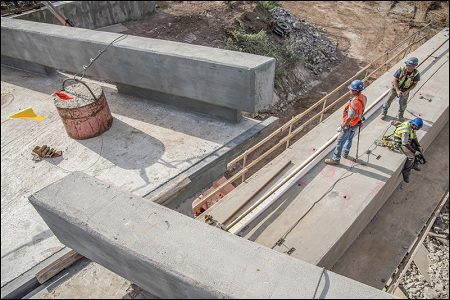Citing a drop in public spending on new infrastructure projects and a slackening in demand for construction, the Associated General Contractors of America called for Congress and President Trump to “act on new measures to fund and finance needed improvements to the nation’s aging infrastructure.”
New government data show that declines this summer in public-sector construction spending – a period when the building industry usually revs up – “come at a time when much of the nation’s public infrastructure is deteriorating due to age or overuse,” the AGC said.
Association officials, the group said in a press release, “urged Congress and the Trump administration to work together to enact new measures to fund and finance needed upgrades to the nation’s aging infrastructure. They noted that these investments are necessary to protect against further deterioration of the nation’s public works. And they added that the new investments would help offset slackening demand for construction.”
The AGC action is the latest from transportation-related groups urging President Trump to follow through on his campaign promises to introduce a major infrastructure investment plan. Administration officials have repeatedly said details were soon to be released, but lawmakers and industry stakeholders have seen that schedule delayed for months as Congress and the White House spent more time on health insurance proposals.
Meanwhile, Trump in his budget plan proposed cutting various types of federal infrastructure spending, including popular TIGER grants and Essential Air Service subsidies to maintain commercial air travel at rural airports.
Congress is still working on 2018 appropriations for transportation and many other areas of government, and will have little time to complete them when it returns in September from a summer recess. If lawmakers do not complete a new spending measure by Sept. 30 they could extend current-year funding levels, which would delay scheduled increases for highway and transit programs.
Stephen Sandherr, the AGC’s chief executive, said: “Washington officials need to act quickly to rebuild our public works before bad roads, unclean water and unreliable power systems begin to serve as a drag on broader economic growth.”
The association’s chief economist, Ken Simonson, said that although overall construction spending is still rising such growth “has become much more uneven across categories in recent months. There has been a steep decline in public investment in nearly all types of construction over the past year. Private nonresidential construction is still rising overall, but generally at slower rates than was occurring a few months ago.”
The industry group highlighted data from the Census Bureau’s Aug. 1 report on U.S. construction spending for June.
The AGC said that “public construction spending plunged 5.4 percent from the prior month and 9.5 percent from June 2016 to June 2017,” while “the biggest public segment – highway and street construction – slumped 8.1 percent from a year earlier.
“Among other major public infrastructure categories, spending on transportation facilities such as transit and airport construction dropped 3.9 percent year-over-year; spending on sewage and waste disposal plummeted 16.1 percent; and spending on water supply fell 17.7 percent. Public spending on educational structures declined 7.3 percent from a year ago.”
The AGC analysis and call for action on infrastructure investment comes as Reuters reports that states and local governments have been issuing fewer new bonds over the past year to help finance new projects, amid uncertainty over President Trump’s delayed infrastructure plan.
“Through July, new municipal deals to fund transportation, utilities and power projects totaled $50.7 billion, down 19.4 percent from the same period last year, according to an analysis of Thomson Reuters data,” the news service said.
It continued: “That decline outpaces a broader drop in the U.S. municipal bond market overall, with total issuance down 13.1 percent thus far in 2017 to $201.7 billion.”


